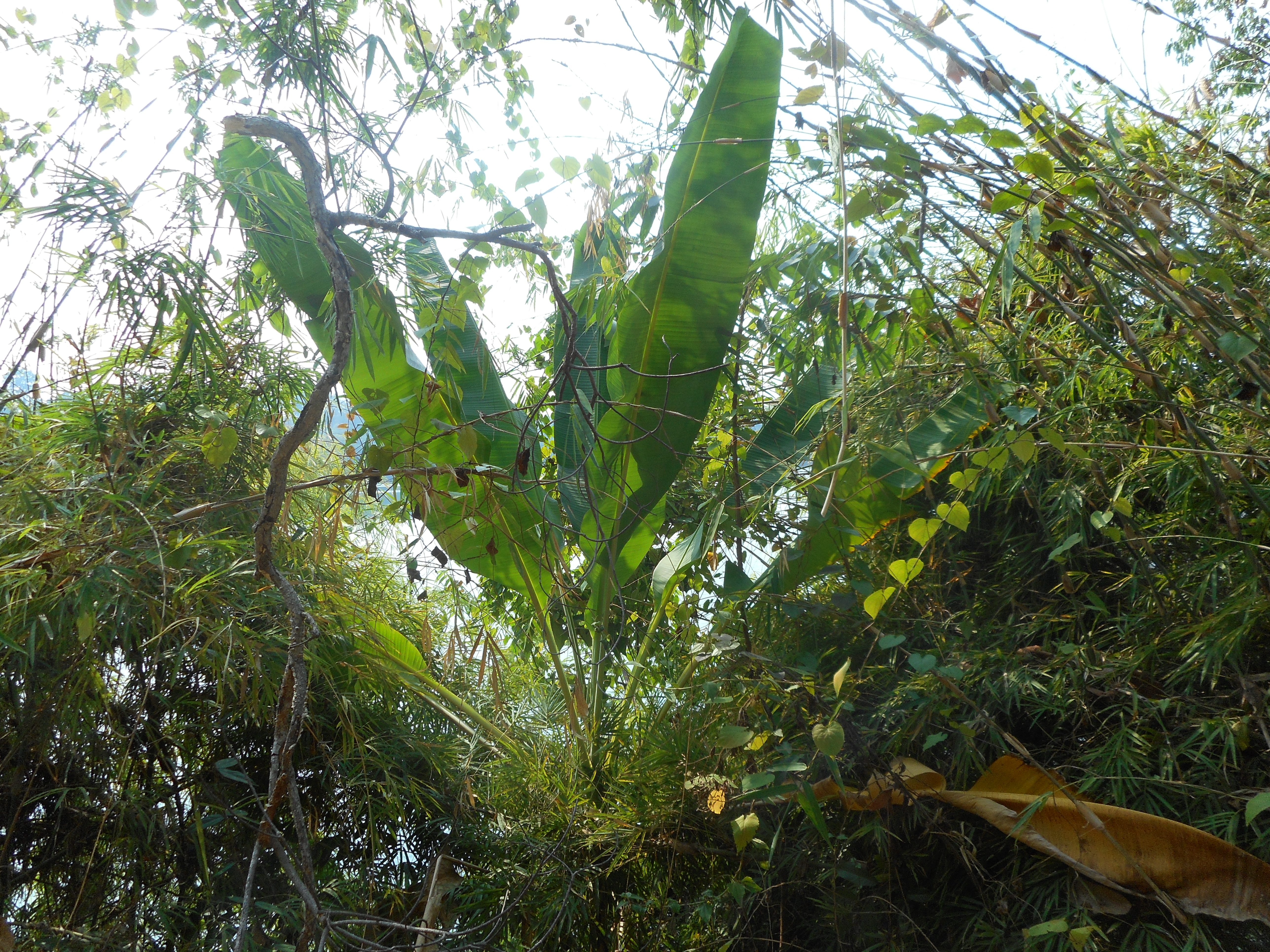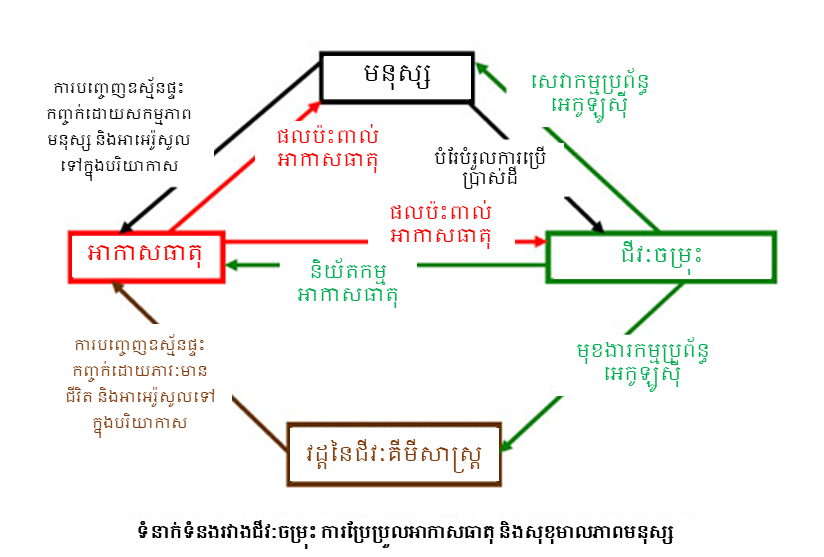ជីវៈចម្រុះ សំដៅដល់សារពាង្គកាយខុសគ្នានៅក្នុងប្រភេទតែមួយ ឬប្រភេទផ្សេងគ្នា និងបណ្តាសារពាង្គកាយរស់នៃគ្រប់លំដាប់ថ្នាក់ និងប្រភពទាំងអស់ រួមទាំងប្រព័ន្ធអេកូឡូស៊ីដែនដីគោក ដែនសមុទ្រ ដែនទឹកសាប និងបណ្តាទំនាក់ទំនងអេកូឡូស៊ី ដែលនៅក្នុងនោះមានប្រព័ន្ធអេកូឡូស៊ីទាំងនេះ។1 ជីវៈចម្រុះគឺមានលក្ខណៈល្អប្រសើរខ្លាំងចំពោះតំបន់ធម្មជាតិដូចជាតំបន់ព្រៃបៃតងជានិច្ច ប៉ុន្តែវាក៏មានសារៈសំខាន់ដូចគ្នានៅក្នុងតំបន់ទីក្រុង។ ជីវៈចម្រុះ គឺពិតជាចាំបាច់សម្រាប់ស្ទើរតែគ្រប់ធនធាននានាដែលប្រើប្រាស់ដោយមនុស្ស ដូចជាម្ហូបអាហារ ទីជម្រក និងឥន្ទនៈ។ លេខាប្រតិបត្តិនៃអនុសញ្ញាស្តីពីជីវៈចម្រុះប្រើនិយមន័យដូចខាងក្រោម៖2
“ជីវៈសាស្ត្រចម្រុះ ទ្រទ្រង់មុខងារនៃប្រព័ន្ធអេកូឡូស៊ី និងផ្តល់នូវសេវានានាដល់ប្រព័ន្ធអេកូឡូស៊ីដែលមានសារៈសំខាន់សម្រាប់សុខុមាលភាពមនុស្សជាតិ។ វាផ្ដល់នូវសន្តិសុខស្បៀង សុខភាព ខ្យល់អាកាសបរិសុទ្ធ និងទឹក វាក៏ចូលរួមចំណែកដល់ជីវភាពរស់នៅរបស់ប្រជាជនក្នុងមូលដ្ឋាន និងការអភិវឌ្ឍផ្នែកសេដ្ឋកិច្ច ផងដែរ… បន្ថែមពីនេះ ជីវៈចម្រុះ គឺជាសមាសភាគកណ្តាលមួយនៃប្រព័ន្ធជំនឿ គតិលោក និងអត្តសញ្ញាណជាច្រើន។”
ជីវៈចម្រុះ គឺពិតជាមានសារៈសំខាន់ៗដល់មនុស្សម្នាក់ៗ បើទោះបីជាវាមិនតែងតែត្រូវបានគេឃើញនៅក្នុងតំបន់ទីក្រុងក៏ដោយ ពីព្រោះវាចូលរួមចំណែកដោយផ្ទាល់ដល់សុខុមាលភាពរបស់មនុស្ស។3 ផលវិបាកនៃការបាត់បង់ជីវៈចម្រុះ គឺកំពុងធ្វើឱ្យមានការភ្ញាក់ផ្អើល ហើយវាកំពុងត្រូវបានគេប្រៀបធៀបទៅនឹងផលវិបាកផ្សេងៗទៀតដែលពាក់ព័ន្ធនឹងការប្រែប្រួលអាកាសធាតុ។4

រុក្ខជាតិកម្ពុជា ក្នុងខេត្តរតនៈគិរី។ រូបថតដោយ Romeo Garreau, ថតនៅថ្ងៃទី ៣០ ខែមេសា ឆ្នាំ ២០១៦។ ក្រោមអាជ្ញាបណ្ណCC BY NC-ND 2.0.
ប្រទេសកម្ពុជាមានជីវៈចម្រុះមួយចំនួនដែលមានតម្លៃបំផុតនៅក្នុងតំបន់អាស៊ីអាគ្នេយ៍។ ប្រភេទសត្វដែលរងការគំរាមកំហែងដូចជា សត្វក្រពើភ្នំ និងដំរីអាស៊ី នៅមានវត្តមាននៅក្នុងព្រៃរបស់ប្រទេសកម្ពុជានៅឡើយ (បើទោះបីក្នុងចំនួនថយចុះខ្លះក៏ដោយ) ខណៈដែលសត្វទាំងអស់នោះមិនត្រូវបានគេប្រទះឃើញ នៅក្នុងព្រៃប្រទេសជិតខាងនានា។5
តាមរយៈការវាស់វែងចំណាត់ថ្នាក់ខុសៗគ្នាដែលបានផ្ដល់ឱ្យ ឃើញថាវាគឺមិនមានភាពងាយស្រួលនោះទេក្នុងការវាយតម្លៃលើជីវៈចម្រុះ រួមបញ្ចូលទាំងប្រភេទសត្វ, ប្រព័ន្ធអេកូឡូស៊ី និងពូជពង្សជាច្រើន ក្នុងចំនោមក្រុមផ្សេងៗជាច្រើនទៀត។6
ប្រព័ន្ធអេកូឡូស៊ី និងប្រភេទសត្វ បង្កើតបានជាទម្រង់ស្មុគស្មាញមួយនៃអន្តរកម្ម។ ការធ្វើឱ្យចុះទន់ខ្សោយនៃគុណប្រយោជន៍ណាមួយនឹងប៉ះពាល់ដល់លំនឹង។ លោកសាស្ត្រាចារ្យ Michel Loreau7 ប្រើប្រាស់ឧទាហរណ៍មួយនៃការបាត់បង់ពពួកសត្វភេសមុទ្រ ដែលនឹងនាំឱ្យពពួកសត្វកាំប្រម៉ាសមុទ្រមានការកើនឡើងដែលខ្លួនវាផ្ទាល់អាចនឹងគំរាមកំហែងដល់ពពួកសារ៉ាយសមុទ្រ ស្ថានភាពនេះនឹងនាំឱ្យមានការគំរាមកំហែងដល់ពពួកសារ៉ាយសមុទ្រ។ ស្ថានភាពនេះនឹងនាំឱ្យមានការផុតពូជនៃភាវៈរស់នានាដែលអាស្រ័យប្រព័ន្ធអេកូឡូស៊ីសារ៉ាយសមុទ្រ ខណៈពេលដែលកំពុងមានការកើនឡើងនៃសំណឹកឆ្នេរសមុទ្រត្រូវបានបង្ការដោយសារ៉ាយសមុទ្រ ហើយផលវិបាកនឹងប៉ះពាល់ដោយផ្ទាល់ដល់ជីវិតមនុស្ស និងការចិញ្ចឹមជីវិត។
ប្រភេទភាវៈជាច្រើនពឹងផ្អែកលើលក្ខខណ្ឌបរិស្ថានជុំវិញវាសម្រាប់ការរស់រានមានជីវិត - ដែលយើងសំដៅថា ជាតំបន់អេកូឡូស៊ី។ នៅពេលដែលប្រភេទសត្វនានាឆ្លងកាត់នូវបទពិសោធន៍នៃភាពប្រែប្រួល នោះវានឹងជះឥទ្ធិពលដល់មជ្ឈដ្ឋានជុំវិញវា។ នៅក្នុងលក្ខណៈទូទៅ កាលណាមានប្រភេទសត្វកាន់តែច្រើន បម្រែបម្រួលដែលបណ្តាលដោយការបាត់បង់នៃភាវៈតែមួយប្រភេទ កាន់តែមិនសូវជាសំខាន់ប៉ុន្មាននោះទេ។ ប្រព័ន្ធអេកូឡូស៊ីដែលរឹងមាំបំផុត គឺជាប្រព័ន្ធមួយដែលមានជីវៈចម្រុះធំទូលំទូលាយ។
ការគំរាមកំហែងណាមួយដល់ជីវៈចម្រុះ វាប្រៀបដូចជាការគំរាមកំហែងដ៏មានសក្តានុពលដល់ជីវភាពរស់នៅ និងរបៀបនៃការរស់នៅប្រកបដោយនិរន្តរភាពរបស់មនុស្ស។ បើទោះបីជាវាកម្រនឹងត្រូវបានគេកត់សម្គាល់ក៏ដោយ វាគឺនៅតែមានភាពសំខាន់ដូចគ្នាសម្រាប់ប្រជាជននៅទីជនបទ បើប្រៀបធៀបនឹងផលប៉ះពាល់នៃសកម្មភាពឧស្សាហកម្មនៅក្នុងរយៈពេលយូរ។8
ជីវៈចម្រុះជាច្រើនរបស់ប្រទេសកម្ពុជា គឺនៅបានកំពុងរកឃើញនៅក្នុងអត្រាជាវិសាមញ្ញ។
នៅរវាងឆ្នាំ ១៩៩៨ និងឆ្នាំ ២០១១ ចំនួននៃប្រភេទថនិកសត្វដែលបានកំណត់ បានកើនឡើងពី ១០០ ទៅ ១៦២ ប្រភេទ ប្រភេទបក្សីកើនពី ៤១០ ទៅ ៥៧៧ ប្រភេទ, សត្វល្មូនកើនពី ៨២ ទៅ ១៧៦ ប្រភេទ, ថលជលិកសត្វកើនពី ២៨ ទៅ ៦៦ ប្រភេទ ហើយមច្ឆាកើនពី ២១៥ ទៅ ៥៧១ ប្រភេទ។9
នេះសបញ្ជាក់ឱ្យឃើញកាន់តែច្បាស់ថា ចំនួនប្រភេទសត្វ និងរុក្ខជាតិជាច្រើនទៀតនៅតែបន្តរកឃើញ។ ឧទារហណ៍ ប្រភេទបណ្ណង្គជាតិ ឬប៉ប្រ៊ក ត្រូវបានកត់សម្គាល់ថា នៅក្នុងប្រទេសថៃមានចំនួន ៦២០ ប្រភេទ, និង ៧១៤ ប្រភេទនៅក្នុងប្រទេសវៀតណាម ហើយចំណែកឯប្រទេសកម្ពុជា គឺមានចំនួនតែ ២១៧ ប្រភេទប៉ុណ្ណោះ។ ប្រទេសកម្ពុជាក៏មានតំបន់ជីវៈចម្រុះជាច្រើន ដែលតំបន់ទាំងនោះមិនត្រឹមតែមិនសូវមានជីវ់ចម្រុះច្រើនសំបូរបែបនោះទេ ប៉ុន្តែមានប្រភេទសត្វក្នុងចំនួនដែលកត់សម្គាល់កំពុងរកការគំរាមកំហែង។ ទិន្នន័យមិនមែនមានភាពទៀតទាត់គ្រប់ពេលនោះទេ។ នៅក្នុងឆ្នាំ ២០១០ IUCN បានបង្កើតតារាងនៃប្រភេទសត្វដែលបានស្គាល់មួយចំនួននៅក្នុងប្រទេសកម្ពុជា។10
ចំនាត់ថ្នាក់ | ប្រភេទសត្វដែលបានស្គាល់សរុប | កំណត់ជាប្រភេទជិតផុតពូជ, កំពុងរងការគំរាមកំហែង, ឬងាយរងគ្រោះនៅលើបញ្ជីក្រហមរបស់ IUCN |
ប្រភេទថនិកសត្វ | ១២៣ | ៣៧ |
សត្វបក្សី | ៥៤៥ | ៣៦ |
ប្រភេទមច្ឆា | ៨៧៤ | ពុំមានទិន្នន័យ |
ប្រភេទសត្វល្មូន | ៨៨ | ១៣ |
ថលជលិកសត្វ | ៦៣ | ១២ |
ប្រភេទរុក្ខជាតិសរសៃ | ២,៣០៨ | ៣៨ |
ផ្កាថ្មរឹង | ២៤ | ពុំមានទិន្នន័យ |
ផ្កាថ្មទន់ | ១៤ | ពុំមានទិន្នន័យ |
ស្មៅសមុទ្រ | ១០ | ពុំមានទិន្នន័យ |
ការគំរាមកំហែងធំៗ ដល់ជីវៈចម្រុះនៅក្នុងប្រទេសកម្ពូជា មានដូចជា៖11
- ការបម្លែងដី/ការបាត់បង់ព្រៃឈើ
- ទំនប់, ផ្លូវថ្នល់ និងហេដ្ឋារចនាសម្ព័ន្ធ រួមមានការអភិវឌ្ឍតំបន់ឆ្នេរ
- ការបូមយកខ្សាច់នៅតាមខ្សែទឹក
- ការនេសាទហួសកម្រិត និងបច្ចេកទេសនេសាទត្រីខុសច្បាប់
- ការប្រមូលផលិតផលព្រៃឈើខុសច្បាប់
- ការជួញដូរសត្វព្រៃខុសច្បាប់12
ក្រៅពីការរឹតបន្តឹងការការពារបរិស្ថាន ការងារសម្រាប់ការកាត់បន្ថយភាពក្រីក្រ គឺជាយន្តការមួយក្នុងចំនោមយន្តការដទៃទៀតដែលអាចជួយដល់ការបន្ធូរបន្ថយសំពាធបរិស្ថាន។13 បញ្ហាកង្វល់នានាស្តីពីជីវភាពរស់នៅ គឺមួយផ្នែកបណ្តាលមកពីការទាញយកធនធានធម្មជាតិ។ យុទ្ធសាស្ត្រជីវភាពរស់តស៊ូប្រែប្រួលអាស្រ័យលើប្រាក់ចំណូលរបស់គ្រួសារ- ប្រាក់ចំណូលកាន់តែច្រើន ភាពងាយរងគ្រោះនៃការប្រែប្រួលបរិស្ថានកាន់តែតិចតួច។ សកម្មភាពកសិកម្មវិលជុំនៅលើដីដដែលអនុញ្ញាតឱ្យកសិករប្រើដីតិច។ ជីវភាពរស់នៅតាមទីជនបទជាទូទៅ ប្រហែលអាចផ្លាស់ប្តូរចំពោះសកម្មភាពបិទកសិដ្ឋាន ដើម្បីកាត់បន្ថយការទន្ទ្រានបរិស្ថាន នេះជាយន្តការមួយដែលអាចនឹងត្រូវបានលើកទឹកចិត្តតាមរយៈការអប់រំ ឬបណ្តាញសង្គម។
បើទោះជាត្រូវបានរងការគំរាមកំហែង កិច្ចគាំពារជីវៈចម្រុះ គឺត្រូវបានលើកឡើងដោយរាជរដ្ឋាភិបាលនៃព្រះរាជាណាចក្រកម្ពុជា រួមទាំងអង្គការមិនមែនរដ្ឋាភិបាលនានា និងសហគមន៍ក្នុងមូលដ្ឋានផងដែរ។ ផ្នែកមួយនៃការងាររបស់ពួកគេនឹងត្រូវបានផ្តោតទៅលើធាតុនានានៃជីវៈចម្រុះដែលមាននៅក្នុងគោលដៅពីរនៃគោលដៅអភិវឌ្ឍន៍ប្រកបដោយចិរភាពរបស់អង្គការសហប្រជាជាតិ៖ គោលដៅទី១៤ ជីវិតក្រោមទឹក និងគោលដៅទី១៥ ជីវិតនៅលើដី។
កម្មវិធីជីវៈចម្រុះនានានៃអង្គការមិនមែនរដ្ឋាភិបាល
នៅតំបន់ខ្លះនៃជីវៈចម្រុះសំខាន់ៗ មានការការពារស្របច្បាប់ ក្នុងនោះមានដូចជា តំបន់អភិរក្សជីវៈចម្រុះសីមា ខេត្តមណ្ឌលគិរី និងតំបន់ព្រៃការពារជួរភ្នំក្រវាញភាគកណ្តាល។
ក្រៅពីរចនាសម្ព័ន្ធស្របច្បាប់សម្រាប់តំបន់ការពារនានា កិច្ចការពារជាទូទៅ គឺជាការចុះហត្ថលេខាព្រមព្រៀងរវាងរាជរដ្ឋាភិបាលកម្ពុជា និងអង្គការមិនមែនរដ្ឋាភិបាលនានា ដើម្បីការអនុវត្តគម្រោងជាក់លាក់សម្រាប់ការការពារធម្មជាតិ។
តំបន់សំខាន់ៗផ្សេងទៀត មានដូចជា ព្រៃឡង់ - ដែលជាតំបន់ព្រៃបៃតងជានិច្ចដ៏ធំបំផុតនៅតំបន់ទំនាបក្នុងប្រទេសកម្ពុជា ហើយវាក៏ជាព្រៃមួយក្នុងចំនោមព្រៃធំបំផុតនៃតំបន់ឥណ្ឌូ-ភូមា ដែលទើបតែទទួលបានការការពារនាពេលថ្មីៗនេះ។ ព្រៃឡង់លាតសន្ធឹងលើផ្ទៃដីខេត្តចំនួន ៤ ក្នុងនោះមានដូចជា៖ ខេត្តក្រចេះ ខេត្តកំពង់ធំ ខេត្តស្ទឹងត្រែង និងខេត្តព្រះវិហារ។
ប្រទេសកម្ពុជា គឺជាប្រទេសដែលសំបូរហូរហៀរ ជាពិសេសធនធានរុក្ខាប្រមាញ់ បើទោះបីជាការការប់ព្រៃឈើនៅតែកត្តាគំរាមកំហែងក៏ដោយ។14 ទាក់ទងនឹងការធ្វើចំណាត់ថ្នាក់ព្រៃឈើ និងអេកូឡូស៊ី គឺមានភាពខុសគ្នាពីចំណាត់ថ្នាក់ព្រៃឈើស្របច្បាប់។ នៅក្នុងប្រទេសកម្ពុជា ព្រៃឈើ ជាមួយនឹងតំបន់ឆ្នេរ រួមទាំងទន្លេ និងបឹង គឺជាអាងស្តុកនៃជីវៈចម្រុះដ៏សំខាន់។
រាជរដ្ឋាភិបាលកម្ពុជា និងអង្គការសមាគមអភិរក្សសត្វព្រៃ (WCS) បានចុះហត្ថលេខាព្រមព្រៀងលើគម្រោងមួយកាលពីឆ្នាំ ២០១៦ ដើម្បីប្រើប្រាស់ថវិកា ២.៦ លានដុល្លារ ដែលបានមកពីការធ្វើពាណិជ្ជកម្មកាបូនមួយជាមួយនឹងក្រុមហ៊ុនឌីសនី។ ថវិកាទាំងនេះ នឹងត្រូវបានប្រើប្រាស់សម្រាប់គោលបំណងអភិរក្សនានានៅក្នុងដែនជម្រកសត្វព្រៃកែវសីមា។ ឥណទានកាបូន គឺជាប្រភពហិរញ្ញវត្ថុដ៏មានសក្តានុពលមួយសម្រាប់ការអភិរក្សនៅក្នុងប្រទេសកម្ពុជា។15
គោលនយោបាយជីវៈចម្រុះរបស់រដ្ឋាភិបាល
ការការពារជីវៈចម្រុះ គឺត្រូវបានលើកឡើងដោយរាជរដ្ឋាភិបាលកម្ពុជាតាមវិធីជាច្រើនយ៉ាង។
នៅខែកុម្ភៈ ឆ្នាំ ១៩៩៥ ប្រទេសកម្ពុជាបានចុះហត្ថលេខាលើអនុសញ្ញាស្តីពីជីវៈចម្រុះ។ នៅក្នុងឆ្នាំ ១៩៩៧ អនុសញ្ញាស្តីពីពាណិជ្ជកម្មអន្តរជាតិទៅលើសត្វព្រៃជិតផុតពូជ (ហៅកាត់ថា CITES) ត្រូវបានផ្តល់សច្ចាប័ន ហើយនៅឆ្នាំដដែលនេះ ក៏មានការបង្កើតផែនការយុទ្ធសាស្ដ្រ និងសកម្មភាពថ្នាក់ជាតិស្តីពីជីវៈចម្រុះផងដែរ។16
ការលើកឡើងទាំងនេះបានបើកផ្លូវឆ្ពោះទៅរកផែនការសកម្មភាពបរិស្ថានជាតិឆ្នាំ ១៩៩៨-២០០២17 ដោយលើកឡើងពីបញ្ហានានាចំនួនបួន៖
- ការគំរាមកំហែងនានាទៅលើជីវៈចម្រុះនៅក្នុងប្រទេសកម្ពុជា
- គម្លាតនានានៅក្នុងតំបន់ការពារដែលមានស្រាប់
- ការរៀបចំច្បាប់ និងស្ថាប័នសម្រាប់ការគ្រប់គ្រងតំបន់ការពារ
- យុទ្ធសាស្ត្រនានាសម្រាប់ការអភិរក្សជីវៈចម្រុះ
នៅក្នុងខែមិថុនា ឆ្នាំ ២០០៩ រាជរដ្ឋាភិបាលកម្ពុជា បានចុះហត្ថលេខាលើកិច្ចព្រមព្រៀងមួយជាមួយនឹងក្រុមហ៊ុន Terra Global Capital ដែលជាក្រុមហ៊ុនមួយផ្តល់សេវាគាំទ្រផ្នែកបច្ចេកទេស និងជំនួញជើងសារសេវាប្រព័ន្ធអេកូឡូស៊ី។ ដោយសង្ឃឹមថា កិច្ចព្រមព្រៀងនេះនឹងជួយកាត់បន្ថយការបាត់បង់ព្រៃឈើ ដូច្នេះការកាត់បន្ថយការបំភាយឧស្ម័នកាបូនឌីអ៊ុកស៊ីតនឹងនៅត្រឹម ៨.៥ លានតោន ក្នុងរយៈពេល ៣០ឆ្នាំទៀត។ ជាលទ្ធផលនៃកិច្ចព្រមព្រៀងនេះ បច្ចុប្បន្នមានព្រៃសហគមន៍ចំនួន ១៣ នៅក្នុងខេត្តឧត្តរមានជ័យ និងមួយនៅក្នុងខេត្តមណ្ឌលគិរី ដែលព្រៃសហគមន៍ទាំងនេះកំពុងរៀបចំចាត់ចែងជាគម្រោងសាកល្បងរេដបូក។
ជំហាននានាត្រូវបានអនុវត្តន៍ ដើម្បីធ្វើឱ្យគោលនយោបាយបរិស្ថានកាន់តែទូលំទូលាយ។ ច្បាប់ស្តីពីតំបន់ការពារឆ្នាំ ២០០៨ បានជំនួសច្បាប់ឆ្នាំ ១៩៩៣ ដោយមានភ្ជាប់នៅសេចក្តីណែនាំជាក់លាក់ច្រើនជាងមុន។ នាពេលបច្ចុប្បន្ននេះ ក្រមបរិស្ថានកំពុងត្រូវបានពង្រាង ហើយវាគួរតែមានភាពត្រូវគ្នាប្រសើរជាមុនជាមួយនឹងស្តង់ដារអន្តរជាតិ ក៏ដូចជាជួយធានាដល់កិច្ចគាំពារបរិស្ថានបានប្រសើរជាងមុន។
ការការពារជីវៈចម្រុះ ត្រូវបានគេលើកឡើងដោយផ្តោតទៅលើទាំងឯកសារគោលនយោបាយណែនាំអភិវឌ្ឍន៍សំខាន់ៗរបស់រដ្ឋាភិបាល នៃយុទ្ធសាស្ត្រចតុកោណដំណាក់កាលទី៣ និងផែនការយុទ្ធសាស្ត្រអភិវឌ្ឍន៍ជាតិ ២០១៤-២០១៨។ នៅក្នុងឯកសារទាំងពីរនេះនិយាយអំពីជីវៈចម្រុះនៅក្នុងបរិបទនៃការធ្វើឱ្យមានតុល្យភាពរវាងការអភិវឌ្ឍនិងការអភិរក្ស។1819
កង្វះខាតនៃក្រុមមនុស្សដែលមានជំនាញនៅក្នុងកិច្ចការគ្រប់គ្រងការអភិរក្ស ត្រូវបានកត់សម្គាល់ ហើយវាកំពុងត្រូវបានគេលើកឡើងមកពិភាក្សាតាមមធ្យោបាយផ្សេងៗជាច្រើន។ ជាឧទាហរណ៍ មជ្ឈមណ្ឌលអភិរក្សជីរៈចម្រុះ នៅឯសាកលវិទ្យាល័យភូមិន្ទភ្នំពេញ កំពុងបណ្តុះបណ្តាល និងគាំទ្រដល់អ្នកវិទ្យាសាស្ត្រកម្ពុជា។20
ការទទួលខុសត្រូវផ្នែកឧស្សាហកម្មទៅលើជីវៈចម្រុះក៏ត្រូវបានលើកឡើងផងដែរ។ ទស្សនៈនៃការអភិវឌ្ឍការវាយតម្លៃហេតុប៉ះពាល់បរិស្ថាន បានដាក់បញ្ជូលនូវបញ្ហានានាអំពីជីវៈចម្រុះ។
បានធ្វើបច្ចុប្បន្នភាព៖ ០៥ ធ្នូ ២០១៧
ទាក់ទងនឹងជីវៈចម្រុះ
ឯកសារយោង
- 1. វាក្យស័ព្ទនៃ”ច្បាប់ស្តីពីតំបន់ការពារ ឆ្នាំ ២០០៨”។ ចូលអានថ្ងៃទី ០៥ ខែធ្នូ ឆ្នាំ២០១៧។ https://opendevelopmentcambodia.net/km/dataset/?id=5f94811e-f6fa-4a25-b73f-2271aaf6a096
- 2. ផែនការយុទ្ធសាស្ត្រសម្រាប់ជីវៈចម្រុះ ២០១១-២០២០ និង គោលដៅ Aichi, លេខាធិការដ្ឋានសម្រាប់ការអភិរក្សជីវៈចម្រុះ, លោក Braulio F. De Souza Dias UNEP. មេសា ២០១៦។ ចូលអានថ្ងៃទី ២៣ ខែសីហា ឆ្នាំ២០១៦។ https://www.cbd.int/doc/speech/2016/sp-2016-04-04-chm-workshop-rs-en.pdf
- 3. M. Dallimer, K. Irvine, A. Skinner, Z. Davies, J. Rouquette, L. Maltby, P. Warren, P. Armsworth, K. Gaston. (២០១២). “ជីវៈចម្រុះ និងកត្តាអារម្មណ៍ល្អ: ការស្វែងយល់ពីទំនាក់ទំនងរវាងសុខុមាលភាពមនុស្សដែលបានរាយការណ៍ដោយខ្លួនឯង និងភាពសំបូរបែបនៃប្រភេទសត្វ “. វិទ្យាស្ថានវិទ្យាសាស្រ្តជីវសាស្រ្តអាមេរិច. ចូលអានថ្ងៃទី ២៣ ខែសីហា ឆ្នាំ២០១៦។ http://bioscience.oxfordjournals.org/content/62/1/47.full
- 4. B. Cardinale, J. Duffy, A. Gonzalez, D. Hooper, C. Perrings, P. Venail, A. Narwani, G. Mace, D. Tilman, D. Wardle, A. Kinzig, G. Daily, M. Loreau, J. Grace, A. Larigauderie, D. Srivastava, S. Naeem. (២០១២). “ការបាត់បង់ជីវៈចម្រុះ និងផលប៉ះពាល់របស់វាមកលើមនុស្សជាតិ”. សាលាធនធានធម្មជាតិ និងបរិស្ថាន. ចូលអានថ្ងៃទី ២៤ ខែសីហា ឆ្នាំ២០១៦។ http://snre.umich.edu/cardinale/wp-content/uploads/2012/04/Cardinale-et-al-Nature-2012.pdf
- 5. អង្គការសត្វព្រៃ និងរុក្ខជាតិអន្តរជាតិ (FFI). ចូលអានថ្ងៃទី ៥ ខែកក្កដា ឆ្នាំ២០១៥។ http://www.fauna-flora.org/explore/cambodia/
- 6. Harold Levrel. (២០០៧). “តើមានសូចនាករអ្វីខ្លះសម្រាប់ការគ្រប់គ្រងជីវៈចម្រុះ” វិទ្យាស្ថានជីវៈចម្រុះនៃប្រទេសបារាំង។ ចូលអានថ្ងៃទី ០៥ ខែឧសភា ឆ្នាំ២០១៦។ http://temis.documentation.developpement-durable.gouv.fr/documents/Temis/0066/Temis-0066100/18350.pdf
- 7. Michel Loreau. “ផលវិបាកអេកូឡូស៊ីចំពោះការបាត់បង់ជីវៈចម្រុះ”។ ដេប៉ាតឺម៉ងជីវវិទ្យា, សាកលវិទ្យាល័យ McGill។ ចូលអានថ្ងៃទី ២៤ ខែសីហា ឆ្នាំ២០១៦។ http://www.interacademies.net/File.aspx?id=10351
- 8. Greenfacts. (២០០៥). “ជីវៈចម្រុះ និងសុខុមាលភាពមនុស្ស”។ ចូលអានថ្ងៃទី ២៤ ខែសីហា ឆ្នាំ២០១៦។ http://www.greenfacts.org/en/biodiversity/
- 9. J. Daltry. (២០១១). “អ្នកស្វែង, អ្នកថែរក្សា”. ទិនានុប្បវត្តិប្រវត្តិធម្មជាតិកម្ពុជា.
- 10. អង្គការសហភាពអន្តរជាតិដើម្បីអភិរក្សធម្មជាតិ (IUCN). “បញ្ជីក្រហមនៃប្រភេទសត្វដែលរងការគំរាមកំហែង របស់អង្គការ IUCN.” ចូលអានថ្ងៃទី ២៣ ខែសីហា ឆ្នាំ ២០១៦។ http://www.iucnredlist.org/
- 11. អង្គការមូលនិធិសត្វព្រៃពិភពលោក (WWF). (២០១០). “ការគំរាមកំហែងជីវៈចម្រុះកម្ពុជា”។ ចូលអានថ្ងៃទី ២២ ខែសីហា ឆ្នាំ២០១៦. https://assets.panda.org/downloads/threats_and_solutions_wed_posters__eng.pdf
- 12. ឃួន ធារ៉ា. “ការជួញដូរសត្វព្រៃកំពុងធ្វើឱ្យសត្វព្រៃកម្ពុជាប្រឈមនឹងការជិតផុតពូជ”. វិទ្យុសំលេងសហរដ្ឋអាមេរិក (VOA), ចុះថ្ងៃទី ២៣ ខែមិថុនា ឆ្នាំ២០១៤។ ចូលអានថ្ងៃទី ២៤ ខែសីហា ឆ្នាំ២០១៦។ http://www.voacambodia.com/a/wildlife-trade-endangering-cambodias-fauna/1943063.html
- 13. T. Nguyen, D. Truong, D. Bühlera, R. Hartjea, U. Grote. (២០១៥). ”ជីវភាពនៅទីជនបទ និងការពឹងផ្អែកធនធានបរិស្ថាននៅកម្ពុជា”, វិទ្យាស្ថានសេដ្ឋកិច្ចបរិស្ថាន និងពាណិជ្ជកម្មពិភពលោក។ ចូលអានថ្ងៃទី ២៣ ខែសីហា ឆ្នាំ២០១៦។ http://www.sciencedirect.com/science/article/pii/S0921800915004322
- 14. ផាក ស៊ាងលី. “មនុស្សបួននាក់ត្រូវបានផ្តន្ទាទោសទាក់ទងនឹងការឆ្ការព្រៃ”. កាសែតភ្នំពេញប៉ុស្តិ៍, ចុះថ្ងៃទី ២០ ខែមករា ឆ្នាំ២០១៤។ ចូលអានថ្ងៃទី ២៤ ខែសីហា ឆ្នាំ២០១៦។ http://www.phnompenhpost.com/national/four-charged-over-forest-clearing
- 15. Safiya Charles. “ឥណទានកាបូននឹងចាប់ផ្តើម”. កាសែតខ្មែរថាមស៍, ចុះថ្ងៃទី ១២ ខែសីហា ឆ្នាំ ២០១៦។ ចូលអានថ្ងៃទី ២៤ ខែសីហា ឆ្នាំ២០១៦។ https://www.khmertimeskh.com/7680/carbon-credits-the-start-minister/
- 16. រាជរដ្ឋាភិបាលកម្ពុជា. (២០០២). “ផែនការយុទ្ធសាស្ដ្រ និងសកម្មភាពថ្នាក់ជាតិស្តីពីជីវៈចម្រុះ”. ចូលអានថ្ងៃទី ០៥ ខែឧសភា ឆ្នាំ២០១៦។ https://www.cbd.int/doc/world/kh/kh-nbsap-01-en.pdf
- 17. ពិសី អ៊ុំ. “ផែនការជីវៈចម្រុះនៅក្នុងតំបន់អាស៊ី”. មជ្ឈមណ្ឌលអន្តរជាតិសម្រាប់ការគ្រប់គ្រងបរិស្ថាន។ ចូលអានថ្ងៃទី ០៥ ខែឧសភា ឆ្នាំ ២០១៦។ http://www.icem.com.au/documents/biodiversity/bioplan/cambodia.pdf
- 18. រាជរដ្ឋាភិបាលកម្ពុជា. (២០១៣). “យុទ្ធសាស្ត្រចតុកោណដំណាក់កាលទី ៣”។ ចូលអានថ្ងៃទី ០៥ ខែកក្កដា ឆ្នាំ២០១៥។ http://www.cambodiainvestment.gov.kh/2013-rectangular-strategy-phase-iii.html
- 19. ក្រសួងផែនការនៃព្រះរាជាណាចក្រកម្ពុជា. ផែនការយុទ្ធសាស្ត្រអភិវឌ្ឍន៍ជាតិ ២០១៤-២០១៨។ https://opendevelopmentcambodia.net/dataset/?id=national-strategic-development-plan-2014-2018
- 20. ដូចឯកសារយោងខាងដើម។


